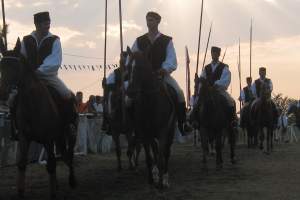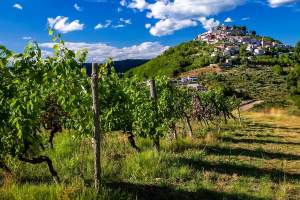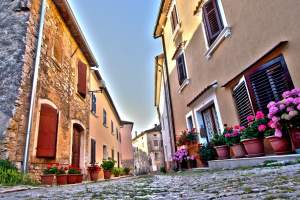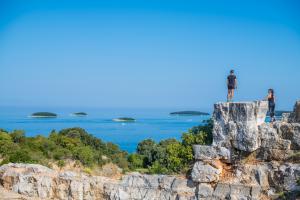Pazin
Pazin is the administrative center of Istria County and already in the 19th century, mostly because of its central position on the Peninsula, but importance as well, came to be called the “heart of Istria”.
Get to know Pazin
Pazin is the administrative center of Istria County and already in the 19th century, mostly because of its central position on the Peninsula, but importance as well, came to be called the “heart of Istria”. The fascinating picture of the medieval Castle of Pazin (Kaštel), situated above the 130 m cliff where the Pazinčica River flows into the Pazin Pit, inspired the renowned French writer Jules Verne as the setting for part of his novel “Mathias Sandorf”, published in 1885. Today there is a Jules Verne club in Pazin and every year at the end of June the Days of Jules Verne are organized.
As a special morphological and hydrological phenomenon, the Pazin Pit was proclaimed a protected landscape in 1964. In the vicinity of the town there are several very interesting medieval towns, whereas devotees of active vacation can enjoy the attractive 10-kilometer-long hiking trail of St. Simon.
History and Heritage
Pazin was mentioned for the first time in 983 in a deed by which Emperor Oton acknowledges the presentation of the fortification Castrum Pisinum to the Bishops of Poreč. In the 12th century the Bishops conceded the castle to their advocatus, Count Majnard Črnogradski (Meinhard von Schwarzenburg), who soon extended his dominion to Tinjan and Kašćerga thus setting the foundations of an estate which would undergo a fate completely different from the rest of Istria until the arrival of Napoleon. After Meinhard's death, the estate was shortly administered by his daughter Matilda who referred to herself as the Countess of Pazin. By her marriage to the Count Engelbert of Gorizia the estate became one of the titles of the Counts of Gorizia.
At the same time, due to continuous strifes between the three sides, the power of the Counts of Gorizia was increasing. Also increasing was the power of Venice which was obtaining power over the coastal towns. The power of the Patriarchs of Aquileia, who claimed the majority of property in Istria, was meanwhile decreasing. The Counts of Gorizia were now known as Counts of Gorizia and Istria and for a while they even had their seat and a palace in Pazin. Parts of their estate were administered on their behalf by ministeriali and militi – members of the subordinated lower nobility who, not only by warfare but also through well planned marriage bonds, obtained new property for their masters. In those times the Counts of Gorizia possessed, apart from the wider area of Pazin, Završje, Momjan, Sovinjak, Pietrapelosa, Lupoglav, Tinjan, Kršan, Kožljak, Žminj, Višnjan-Visignano, Vižinada-Visinada. They also had certain property or rights at Motovun-Montona, Lovreč and Tar-Torre. However, the boundaries were constantly changing and becoming the object of disputes. This situation led to the creation of the oldest Croatian international document – ISTARSKI RAZVOD (The Istrian Book of Boundaries) written in three languages: Latin, German and Croatian (in Glagolitic script).
In 1374 Albert IV, the Count of Gorizia, died without leaving an heir. On the basis of an inheritance contract his Istrian estate, now for the first time referred to as the County of Pazin (Pazinska knežija), became the property of the Habsburg Family. The Habsburgs had already come into possession of large estates in Austria, Carinthia, Carniola, Styria and Tyrol and did not pay much attention to the Istrian estate. The estate was thus used as a source of income necessary to finance their rise to the throne of the Holy Roman Empire of the German Nation and was frequently leased or mortgaged to allied noblemen. Pazin thus saw well known names of late medieval Counts: Devinski, Walsee, Della Torre, Durr (Duerrer), Mosconi, Swetkowitz, Khevenhüller, Kaitschach, Fugger, Barbo, Eggenberg, Flangini, Porzia, Auersperg, Turinetti de Prie. They usually did not reside in Pazin but either subleased the estate for short terms or appointed Captains to administer it. The aim of all these lords was to earn as much revenue from the fiefdom as possible and the pressure on the peasants was on the verge of endurance. This led to a number of revolts such as in 1409, 1571, 1631, 1653 and 1737. The revolts are depicted in an exhibition displayed in the Castle.
The County of Pazin was eventually purchased by the personal counsellor to Empress Maria Theresa, Count Antonio Laderchi, Marquis of Montecuccoli. The Castle of Pazin remained in the possession of the family until 1945. However, the states around the Castle did change. In 1797 the fall of Venice into Napoleon's hands swept away the half-millennial division of Istria between two states. The whole of Istria first became part of Austria, then the former Venetian part devolved to Napoleon in 1805 only to return to Austria in 1809 and, in the same year, the whole of Istria (including Pazin and central Istria) went back to Napoleon.
The status quo was preserved until 1813 when Captain Josip Lazarić, said to be born in Lindar near Pazin, led a troop of soldiers from the then Austrian Rijeka into Istria. The local people welcomed him and helped him in his assault on the French army at the foot of Lindar. Fleeing in the direction Pazin and on towards Beram, where finally defeated, the French hurled most of their heavy artillery down the Pazin Precipice.
Istria was soon completely under the dominion of Austria and in 1825 Pazin became the seat of the Pazin District which, apart from Istria, included the Kvarner islands. After 1860 Istria was promoted a Margravate with its own Parliament and the seat was moved from Pazin to Poreč. From 1867 Istria was part of the Austro-Hungarian Empire and from 1918 it was ruled by the Italians.
Following the capitulation of Italy in September 1943, historic decisions on the joining of Istria with Croatia (forming part of the then Yugoslavia) were adopted in Pazin. Unfortunately, during the same month, after bombing of the town and a massive German offensive, the whole of Istria became part of Adriatisches Kuestenland, a region of the German Reich. Pazin was finally liberated from German occupation on 8 May 1945. In this way, 1400 years after the arrival of the first Slavic people into this region, the majority Croatian population of central Istria joined for the first time in history other Croatians in the same state.
In 1991 Slovenia and Croatia became independent states and since 1993 Pazin has been the administrative seat of the Region of Istria.

















